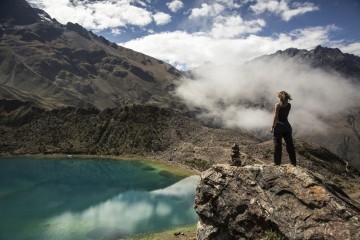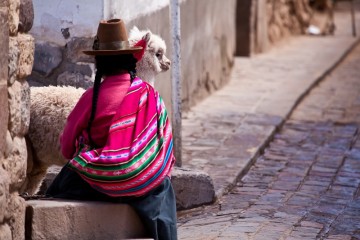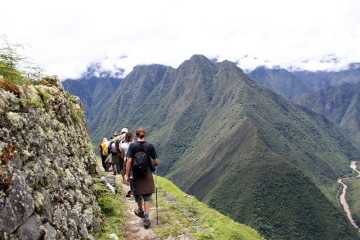Join us on a virtual adventure and learn all about walking the world-famous Inca Trail to Machu Picchu in Peru
Hiking the famed Inca Trail to Machu Picchu in Peru is one of the most coveted highlights for many visitors to South America. Even among more mature travellers, who have the comfortable option of reaching the mystical Inca city by luxury train or bus, taking on the challenge of a multi-day hike through the high-Andes remains immensely popular. With our guide to all you need to know about walking the Inca Trail, we aim to satisfy your curiosity and unravel the mysteries of this incredible adventure: the ins and outs of the multi-day Machu Picchu hike, the logistics involved and what you can expect. Here are the most important things you should know about the Inca Trail to Machu Picchu.
Click the links below to skip through the article:
- Acclimatising is essential
- Age is no indication of success
- Day two is the hardest
- Best time
- Permits are compulsory
- Guides are compulsory
- You get what you pay for
- Not just about Machu Picchu
- Good-quality gear is essential
- Alternative routes
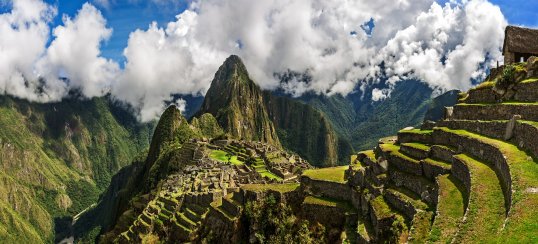
The view of Machu Pichuu from the end of the Inca Trail
There isn’t just ‘one’ Inca Trail – Peru is traversed by thousands of kilometres of ancient Inca trails and there are actually several which lead to Machu Picchu. For tourist purposes, however, the ‘Inca Trail’ is meant as the 4-day hike starting at KM 82 of the railway line to Aguas Caliente, which runs for 42km across the Andes, finally guiding you to the famed Sun Gate, usually on the 4th hiking day. This is known as the Classic Inca Trail. Alternatives are listed at the end of this guide.
Overnight camping is the only accommodation option if taking the Classic Inca Trail – There aren’t any lodges along the classic trail to Machu Picchu so if you wish to follow this trail, you will have to sleep in tents (which are provided for you).
Acclimatising is essential
Check out all our trips to Peru.
The Inca Trail isn’t all at high altitude yet having to tackle two Andean passes reaching almost 4000m means it’s quite important to be acclimatised to the altitude beforehand. Make sure you stay in Cusco for a few days before you take on this challenge and you will have a much better time of it all. On the Inca Trail, you’ll be going up and down quite a lot, traversing low-altitude valleys and sky-reaching passes. Machu Picchu itself sits at a respectable (and more breathable) height of 2430m.
Read our comprehensive Guide to Machu Picchu
Age is no indication of success
Get some inspiration from our trips to Peru.
High-altitude hiking is one of those unique challenges which are very, very personal. The most common recipe for success and ultimate enjoyment of the Inca Trail is prior acclimatisation, taking it slowly along the route and doing all the right things beforehand, like getting plenty of sleep, avoiding alcohol and reducing food intake. The Inca Trail has been successfully completed by 80-year olds and found to be a colossal challenge to 20-year olds. Your age is no indication of how hard (or easy) you will find the hike although it reasons that the fitter you are, the better you’ll cope. Take it easy and you’ll be just fine!
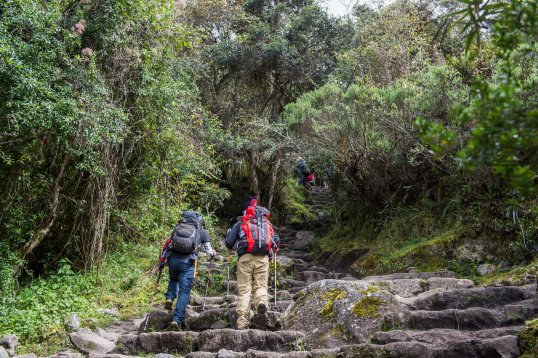
Hikers walking the steps on the Inca Trail
Day two is the hardest day for most
Include Machu Picchu to your chosen itinerary of Peru.
The first day of the Inca Trail is a warm-up, meant to loosen your legs and get you used to a slow and steady hiking pace. Day 2, on the other hand, is by far the most challenging. On this day, you will cross over both high-altitude passes of the trail, hiking for an average of 9 hours. Day 3 is the downhill section through a stunning stretch of the Amazonian cloud forest, a totally mesmerizing experience and one which is easier on your lungs but brutal on your knees. Day 4 starts in pitch-black darkness so you can reach the famed Sun Gate by sunrise. On this day, your hiking time is very short, perhaps 2 or 3 hours only. All up, the Inca Trail stretches for 42 km.
Want to walk through the Sun Gate at sunrise? Classic Inca Trail hike, you must! – Bus and train rides to Machu Picchu are certainly luxurious ways to visit the site yet although you can reach the citadel by sunrise (only by bus) you won’t get to see it through the Sun Gate. Only the Classic Inca Trail offers this unrivalled option.
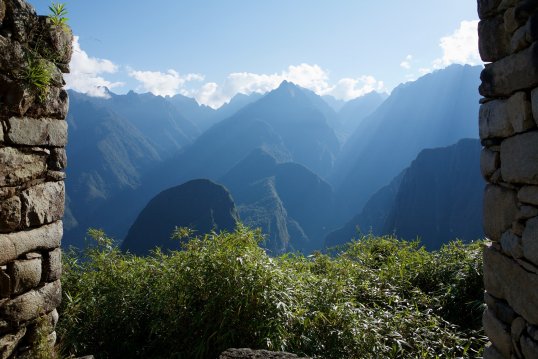
The view through the Sun Gate, Machu Picchu
Best time to do the Inca Trail to Machu Picchu
Create your own holidays to Peru. Contact Viva.
Rain is your enemy along the Inca Trail so the best time to tackle this challenge is during the dry season, between May and September. The busiest months are June-August which coincide with summer vacation time in the northern hemisphere. Do note that the Inca Trail is closed for maintenance in February, every year.
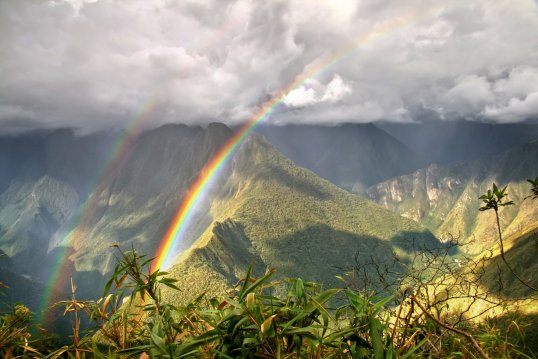
Rainbows on the Inca Trail
Permits are compulsory and numbers restricted
Book your trip to Peru here.
The Peruvian government limits the number of hikers on the famed Inca Trail and, as you can imagine, permits sell out months in advance. Only 500 people are allowed to start the Classic Inca Trail to Machu Picchu on any given day and this includes hikers, guides and their porters. In 2019 permits went on sale on the 1st October. Usually, 6-8 months’ advance bookings are recommended. Let us know as soon as you decide to visit Peru and we can secure your hiking permits and Machu Picchu entry tickets, which are sold separately. Do note that if you also want to climb Huayna Picchu (the smaller peak next to the citadel which affords magnificent views) you’ll have to buy separate permits for that too.
Read all about Huayna Picchu before booking your trip
Guides are compulsory
Choose your trip here.
The Inca Trail to Machu Picchu is a strictly regulated activity in Peru and guides are compulsory. Whilst you could certainly hire a private guide for yourself or family alone, most people join groups to share the expense and the burden of carrying gear. Group hikes are exceptional experiences, offering the comfort of fully-supported hikes with large tents, comfortable mattresses and the luxury of three sensational meals a day. Besides all this convenience, guides are incredibly knowledgeable and really bring the Inca Trail to life, making them priceless hiking companions.
Porters are lifesavers
Hike IncaTrail during one of our tours to Peru.
Inca Trail porters are the unsung heroes of all Inca Trail expeditions. They carry all the necessary food and camping equipment for the group plus your personal camping gear, leaving you to carry only a small daypack for your daily essentials like water, snacks, sunscreen and camera equipment. Porters’ weight loads are limited to 20kgs so the more stuff you bring, the more porters you’ll have to pay for. Keep it light and smart and one porter per person will be sufficient.
On the Inca Trail, you get what you pay for
Check all our trips to Peru.
Like all things in life, you do get what you pay for on the Inca Trail. Top-end companies offer larger tents, more luxuries, more porters and guides, a higher level of comforts, smaller groups and much better-quality gear, overall. Most importantly, reputable high-end companies really look after the porters which are incredibly important: these guys do all the hard work and always deserve excellent recognition, protection – and fair pay.
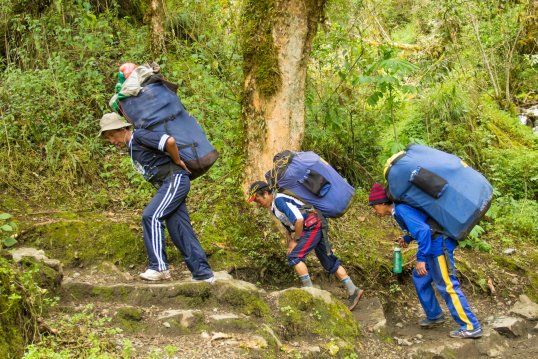
Porters on the Inca Trail
The Inca Trail isn’t just about reaching Machu Picchu
Explore Peru with Viva tours.
The ancient Inca citadel is certainly the cherry atop a magnificent cake, yet it isn’t, by all means, the only highlight of the Inca Trail. On your expedition, you’ll visit important (yet lesser-known) Inca sites along the way, some of which are just as spectacular as Machu Picchu. You’ll cast your eyes on some of the most magnificent landscapes in the entire continent, see wildlife, walk by remote villages and get a glimpse of what life is like in the high Andes. You’ll also tackle an insane number of steps and challenge yourself physically and mentally. The Inca Trail is no walk in the park yet it’s one of the most satisfying challenges you’ll ever tackle and a truly unforgettable experience. Then, in the end, comes Machu Picchu!
Good-quality gear is essential, so pack smart
Contact Viva to include your favourite destinations to your holidays in Peru.
Great (and well worn-in) hiking boots will save your ankles and walking poles will save your knees, especially when going downhill. Expect every climate imaginable and pack accordingly. Hiking up at high altitude will raise your body temperature so dress in layers: T-shirts when it’s sunny and you’re all heated up and a good jacket, windbreaker and rain poncho for when the weather-gods turn against you. Pack a headtorch for night-time camping (and last-day hiking), insect spray, sunscreen lotion, hat, sunglasses and bring your own toilet roll in a zip-lock bag.
Book your return journey for the late-afternoon – The Inca Trail is an exhausting endeavour and the only real downside to it is that one tends to arrive at Machu Picchu with little energy left. It’s a genius idea to stay all day and book your return trip to Cusco for the late afternoon, buying both a morning and afternoon ticket for the citadel. This gives you the chance to take your time with touring the site, enjoy plenty of breaks as well as climb stunning Huayna Picchu.
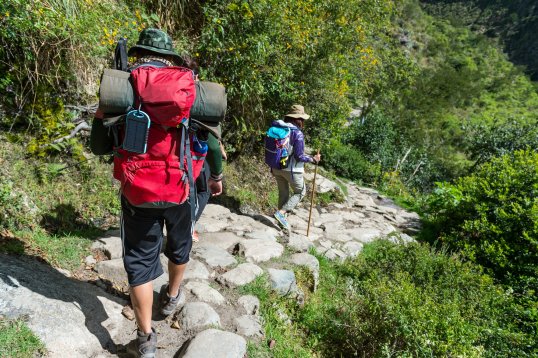
Hikers with back packs walking on the Inca Trail
Alternative routes to Machu Picchu
Discover the diversity of Peru.
The Classic Inca Trail to Machu Picchu is a wonderful bucket-list highlight for anyone who dreams of Peruvian adventures yet if you’re planning a last-minute visit and can’t secure permits– or prefer to hike with fewer fellow visitors – there are two fabulous alternatives that mean you can enjoy all the hiking highlights – and visit Machu Picchu – at short notice.
Both the Lares and Salkantay treks are incredibly rewarding adventures and offer just as many highlights as ‘the real deal’ on a more off-the-beaten-trail experience. Do note, however, that neither one of these hikes offers the option to trek all the way to Machu Picchu.
The Lares Trek
Click here to book your trip to Peru.
The Lares Trail is usually taken over 4-5 days, starting from the glorious Lares Valley (about 60km north of Cusco) and ending in Ollantaytambo, from where you can catch the train to Machu Picchu. This is fast becoming the most popular alternative to the Classic Inca Trail due to permit restrictions for the latter and is, without a doubt, a stupendous hiking option if you’ve actually visited Machu Picchu before and simply wish to experience a different trail. The Lares Trek can be taken as a stand-alone adventure: you can return to Cusco from Ollantaytambo and not visit Machu Picchu if you’ve already been. This trek also serves up fantastic cultural experiences, as the Lares Valley is home to authentic farming villages which seem to have been unperturbed by the passing of time.
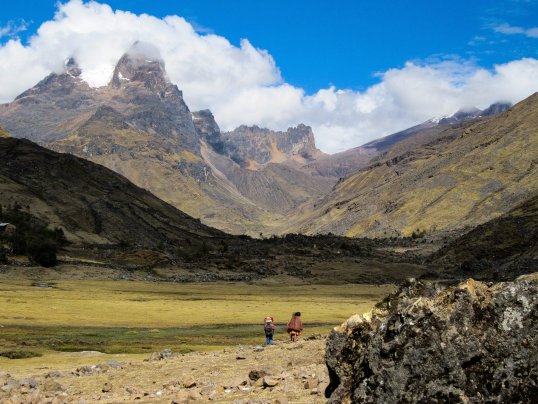
Mountains on the Lares Trek
The Salkantay Trek
Explore the wonders of incredible nature during our trips to Peru.
The National Geographic named the outstanding Salkantay Trek as one of the world’s 25 best treks and we certainly wouldn’t disagree. This longer Machu Picchu hiking option starts from the town of Mollepata, 150km west of Cusco, and meanders around and over the magnificent Vilcabamba Mountain range, skirting the spellbinding Mt Salkantay: a 6271m glacier-capped peak once worshipped by the ancient Incas. Offering an exceptionally authentic and unique adventure, this week-long adventure is in a league of its own and aimed at discerning hikers who want to experience an incredible side of Peru, walking along a sacred ancient trail. The trail ends at Aguas Caliente where, as is the case with the Lares, you can take the train or bus up to Machu Picchu.
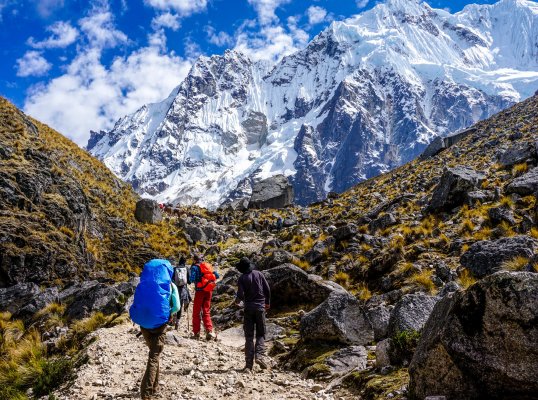
A view of the mountains on the Salkantay trek
At Viva Expeditions, we offer an array of fabulous options for walking the Inca Trail to Machu Picchu. We also offer unique luxury hiking options – on the stunning Salkantay Trek – where you can overnight in beautiful mountain lodges instead of camping. For more details, you can contact us right here.
Laura Pattara
Laura Pattara writes for Viva Expeditions with a special love for all things Latin America. She had guided overland tours across the continent, reached Machu Picchu five times on foot, and even dressed up as a giant toucan for Carnaval. With a degree in languages and two decades of global travel experience behind her, Laura has a long-standing love for the Andes, soaring condors, and a truly delicious empanada.
|
